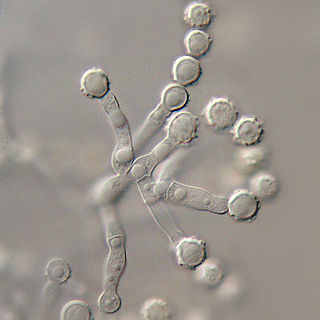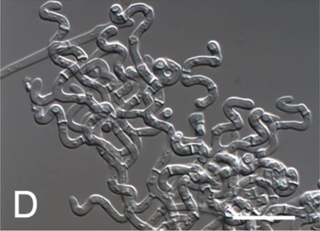
Eurotiomycetes is a large class of ascomycetes with cleistothecial ascocarps within the subphylum Pezizomycotina, currently containing around 3810 species according to the Catalogue of Life. It is the third largest lichenized class, with more than 1200 lichen species that are mostly bitunicate in the formation of asci. It contains most of the fungi previously known morphologically as "Plectomycetes".

Sordariomycetes is a class of fungi in the subdivision Pezizomycotina (Ascomycota). It is the second-largest class of Ascomycota, with a worldwide distribution that mostly accommodates terrestrial based taxa, although several can also be found in aquatic habitats. Some are phytopathogens that can cause leaf, stem, and root diseases in a wide variety of hosts, while other genera can cause diseases in arthropods and mammals.

Neurospora is a genus of Ascomycete fungi. The genus name, meaning "nerve spore" refers to the characteristic striations on the spores that resemble axons.

The order Sordariales is one of the most diverse taxonomic groups within the Sordariomycetes.
Chrysosporium is a genus of hyaline hyphomycetes fungi in the family Onygenaceae.
Monosporascus cannonballus is a species of fungus in the family Diatrypaceae. It is a plant pathogen that causes vine decline of melon and watermelon crops.

The Microascaceae are a family of fungi in the class Sordariomycetes, subclass Hypocreomycetidae. The family was published by David Malloch in 1970, an emended description based on Everet Stanley Luttrell's original 1951 publication. Family was updated in 2020.
Montagnula is a genus of fungi in the family Didymosphaeriaceae. The genus, circumscribed by mycologist Augusto Napoleone Berlese in 1896, contains an estimated 24 species in 2008, but is probably polyphyletic as currently circumscribed. It was originally placed in family Montagnulaceae, before that family was dissolved and it was later placed in family Didymosphaeriaceae, with 34 species.

The Coniochaetales are an order of fungi within the class Sordariomycetes. This order was monotypic and contained a single family, the Coniochaetaceae, historically placed in the order Sordariales. However, this taxonomic placement has been challenged by other authorities, and the Coniochaetales was proposed to include the family Coniochaetaceae. In 2020, family Cordanaceae was added to the order.
Moniliella is a genus of fungi in the subdivision Ustilaginomycotina. It is in the monotypic family MoniliellaceaeQ.M. Wang, F.Y. Bai & Boekhout, which is in the monotypic order MoniliellalesQ.M. Wang, F.Y. Bai & Boekhout which is in the monotypic class MoniliellomycetesQ.M. Wang, F.Y. Bai & Boekhout.

The Onygenaceae are a family of fungi in the Ascomycota, class Eurotiomycetes.

Arachnomyces is a genus of cleistothecial ascomycete fungi described in 1902, of which the anamorph (asexual) stage is the genus Onychocola. Although morphologically similar to members of other families, the fungus now belongs to its own monotypic family Arachnomycetaceae, which is the only family in the monotypic order Arachnomycetales.
The Ceratostomataceae are a family of fungi in the phylum Ascomycota, class Sordariomycetes, subclass Hypocreomycetidae and order Coronophorales.
Scopinella is a genus of fungi in the Coronophorales order. The relationship of this taxon to other taxa within the order was unknown, It has been placed into the family of Ceratostomataceae.

Apophysomyces variabilis is an emerging fungal pathogen that can cause serious and sometimes fatal infection in humans. This fungus is a soil-dwelling saprobe with tropical to subtropical distribution. It is a zygomycete that causes mucormycosis, an infection in humans brought about by fungi in the order Mucorales. Infectious cases have been reported globally in locations including the Americas, Southeast Asia, India, and Australia. Apophysomyces variabilis infections are not transmissible from person to person.

The Coniochaeta are a genus of pleomorphic yeasts of the order Coniochaetales and are pathogens of trees. Some species have also been found to form endophytic associations within plants in which they live inside plant tissues but do not actually harm the organism. They can take the form of pink to brown colonies, hyphae, conidiophores or sclerotia. In 2013, the Lecythophora were merged with the Coniochaeta, following suggestions by Ziauddin Khan et al.
Nannizziopsis guarroi was first documented in 2006 on a variety of lizards then described in Spain in 2010 and was classified as Chrysosporium guarroi, a member of the anamorphic genus Chrysosporium in the family Onygenaceae. Etymologically, the species epithet "guarroi" honours Professor Josep Guarro in recognition of his extensive mycological work including on the genus Chrysosporium. Skin samples taken from pet green iguanas suffering from dermatomycosis were sent to a laboratory for analysis. Five species were isolated and morphologic studies identified the fungus causing the mycoses as a member of the anamorphic species of Chrysosporium. Further investigation of these species using a combination of morphological, cultural and molecular studies showed that they were not identical to any previously described species within the genus Chrysosporium so they were classified as a new species Chrysosporium guarroisp. nov. The delineation of species in the genus Chrysosporium and their assignment to higher taxonomic levels can be challenging due to the marked morphological simplicity of these fungi. Increased scrutiny of strains of these fungi using molecular genetic tools has revealed numerous hidden species and unexpected relationships.
Oidiodendron is a genus of fungi in the family Myxotrichaceae. It has 26 species. The genus was circumscribed by Norwegian forester Håkon Robak in 1932, with Oidiodendron fuscum assigned as the type species. The species is now known as Oidiodendron tenuissimum.
Conioscypha is a genus of terrestrial and freshwater fungi in the monotypic family Conioscyphaceae and the monotypic order Conioscyphales. They are found on decayed wood, leaves, or bamboo stems. Except for Conioscypha japonica which was isolated from dog skin fragments and hair in 2017.
Pararamichloridium is a genus of fungi in the monotypic family Pararamichloridiaceae and within the monotypic order of Pararamichloridiales and also in the subclass Hypocreomycetidae. They are saprobic on wood in terrestrial and freshwater habitats.








